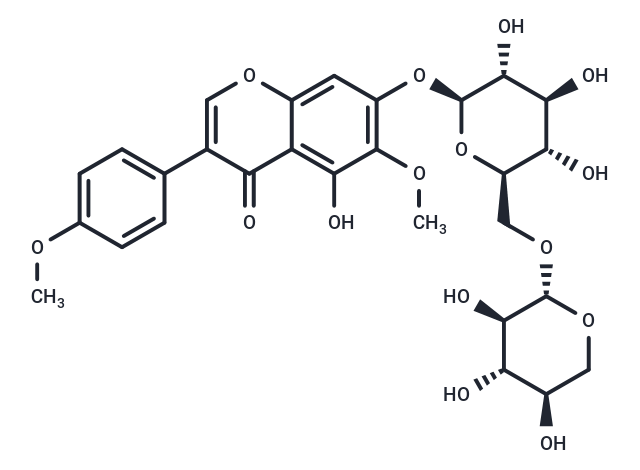Shopping Cart
- Remove All
 Your shopping cart is currently empty
Your shopping cart is currently empty

Kakkalide is a potent lactate dehydrogenase (LDH) inhibitor, it has anti-inflammatory effects.

| Pack Size | Price | Availability | Quantity |
|---|---|---|---|
| 1 mg | $197 | In Stock | |
| 5 mg | $417 | In Stock | |
| 10 mg | $622 | In Stock | |
| 25 mg | $992 | In Stock | |
| 50 mg | $1,330 | In Stock | |
| 100 mg | $1,780 | In Stock |
| Description | Kakkalide is a potent lactate dehydrogenase (LDH) inhibitor, it has anti-inflammatory effects. |
| In vitro | Human umbilical vein endothelial cells (HUVEC) were stimulated with 100 μmol/L palmitate (PA) for 30 min and the effects of 30 min pretreatment with 0.1-10 μmol/L Kakkalide on reactive oxygen species (ROS)-associated inflammation in cells were evaluated by western blot analysis and reverse transcription-polymerase chain reaction. Furthermore, we investigated the biomodulation of insulin signaling by Kakkalide along the insulin receptor substrate (IRS)-1/Akt/endothelial nitric oxide synthase (eNOS) pathway. We also determined the effects of 30 min pretreatment with 0.1-10 μmol/L Kakkalide on insulin-mediated endothelium-dependent vasodilation of rat aorta in vitro following stimulation with 100 μmol/L PA. Kakkalide inhibited ROS overproduction and effectively restored mitochondrial membrane potential, demonstrating its chemoprotection of mitochondrial function. In addition, Kakkalide inhibited ROS-associated inflammation in the endothelium by inhibiting tumor necrosis factor-α± and interleukin-6 production and gene expression, as well as suppressing the phosphorylation of c-Jun N-terminal kinase and IκB kinase β/nuclear factor-κB. Inflammation impaired insulin phosphatidylinositol 3-kinase (PI3K) signaling and reduced insulin-mediated NO production in endothelial cells. Kakkalide facilitated PI3K signaling by positively regulating serine/tyrosine phosphorylation of IRS-1. |
| Molecular Weight | 608.54 |
| Formula | C28H32O15 |
| Cas No. | 58274-56-9 |
| Smiles | COc1ccc(cc1)-c1coc2cc(O[C@@H]3O[C@H](CO[C@@H]4OC[C@@H](O)[C@H](O)[C@H]4O)[C@@H](O)[C@H](O)[C@H]3O)c(OC)c(O)c2c1=O |
| Relative Density. | no data available |
| Storage | store at low temperature,keep away from direct sunlight | Powder: -20°C for 3 years | In solvent: -80°C for 1 year | Shipping with blue ice. | ||||||||||||||||||||
| Solubility Information | DMSO: 10 mM, Sonication is recommended. | ||||||||||||||||||||
Solution Preparation Table | |||||||||||||||||||||
DMSO
| |||||||||||||||||||||

Copyright © 2015-2025 TargetMol Chemicals Inc. All Rights Reserved.